In the intricate web of estate administration, the task of forwarding mail for a deceased individual may seem mundane, yet holds significant legal implications. As accomplished legal practitioners at Morgan Legal Group in the heart of New York City, we navigate the complexities of probate, elder law, and estate planning with precision and expertise. In this article, we dissect the process of USPS forwarding mail for the deceased, shedding light on the protocol and legal considerations that must be carefully observed in this seemingly routine task. Join us as we unravel the legal intricacies surrounding the forwarding of mail for the departed, ensuring that every aspect of estate administration is approached with diligence and proficiency.
Understanding the USPS Forward Mail Service for Deceased Individuals
When a loved one passes away, it can be a difficult and overwhelming time. Handling their affairs, including their mail, is an important part of the process. The USPS Forward Mail Service for deceased individuals is a valuable tool that can help ensure that important mail is properly redirected.
- How it works: The USPS Forward Mail Service for deceased individuals allows for the temporary forwarding of mail from the deceased individual’s address to another specified address. This can help prevent important documents or information from being lost or overlooked during the transition period.
- Benefits: By utilizing this service, family members and estate executors can ensure that they receive any important correspondence or bills that may arrive after the individual has passed away. This can help streamline the handling of the deceased individual’s affairs and prevent any potential issues from arising.

Navigating the Process of Forwarding Mail for a Deceased Loved One
When a loved one passes away, one of the many tasks that need to be taken care of is ensuring that their mail is properly forwarded to the appropriate address. The United States Postal Service (USPS) offers a service to forward mail for deceased individuals, making it easier for family members to handle their affairs. Navigating this process can be complex and overwhelming, but with the right guidance, it can be done efficiently and effectively.
Here are some important steps to consider when forwarding mail for a deceased loved one:
- Notify USPS: Contact the local post office where the deceased individual received mail and inform them of the passing. Provide the necessary information and documentation to begin the mail forwarding process.
- Update addresses: Make sure to update the forwarding address for all mail to ensure that important documents and correspondence are received promptly.
- Monitor mail: Keep track of any mail that is received and ensure that it is forwarded correctly. If there are any issues or discrepancies, contact USPS for assistance.

Recommendations for Efficiently Handling USPS Mail Forwarding After a Death
When a loved one passes away, handling their affairs can be overwhelming. One important task to take care of is managing their mail forwarding with USPS. Here are some :
- Notify USPS: Contact USPS as soon as possible to inform them of the individual’s passing. This will ensure that their mail is forwarded to the appropriate address.
- Update Forwarding Address: Provide USPS with the correct forwarding address for the deceased individual’s mail. Make sure to include any necessary information, such as a PO box number or apartment number.

Ensuring Compliance with USPS Policies and Procedures for Forwarding Mail for Deceased Persons
When it comes to forwarding mail for deceased individuals through USPS, it is crucial to ensure compliance with all policies and procedures set forth by the postal service. Failure to adhere to these guidelines can result in delays, lost mail, and potential legal issues. To guarantee a smooth transition of mail for deceased persons, it is essential to follow the steps outlined below:
<ul>
<li>Notify USPS of the individual's passing and provide necessary documentation, such as a death certificate.</li>
<li>Complete a Change of Address form for the deceased individual to forward their mail to the appropriate recipient.</li>
<li>Ensure that all mail forwarding requests are in line with USPS regulations to avoid any disruptions in service.</li>
</ul>| Key Points: |
|---|
| Notify USPS of the individual’s passing. |
| Complete a Change of Address form. |
<p>By following these guidelines and best practices, you can <strong>effectively manage the forwarding of mail for deceased persons</strong> while ensuring compliance with USPS policies. Remember to communicate openly with USPS representatives and provide all necessary documentation to facilitate a seamless process.</p>Q&A
Q: What happens to mail sent to a deceased person?
A: The USPS offers a Forward Mail service for deceased individuals to ensure their mail is redirected to the appropriate party.
Q: How can I request mail forwarding for a deceased loved one?
A: To forward mail for a deceased individual, you can visit the USPS website or contact your local post office to request the service.
Q: What information will I need to provide to forward mail for a deceased person?
A: You may need to provide proof of the individual’s death, as well as their name and address, in order to complete the Forward Mail request.
Q: Can I temporarily forward mail for a deceased person?
A: Yes, you can choose to temporarily forward mail for a deceased individual if needed.
Q: How long will mail be forwarded for a deceased individual?
A: Mail can be forwarded for up to 12 months for a deceased individual, giving you ample time to handle their affairs.
Final Thoughts
In conclusion, the United States Postal Service offers a valuable service for forwarding mail for deceased individuals. This service helps ensure that important correspondence reaches the proper recipients in a timely manner. While dealing with the loss of a loved one can be difficult, knowing that the USPS is there to assist with mail forwarding can provide some peace of mind during a challenging time. If you have any questions or need assistance with forwarding mail for a deceased individual, do not hesitate to contact your local post office for guidance. Thank you for reading.
 USPS Forward Mail for Deceased: How to Manage Mail After a Loved One Passes Away
USPS Forward Mail for Deceased: How to Manage Mail After a Loved One Passes Away
Losing a loved one is a difficult experience, and during this time, many practical matters must be dealt with, including managing their mail. The United States Postal Service (USPS) has a service that allows for the forwarding of mail for a deceased individual, easing the transition for their family and loved ones. In this article, we will discuss the USPS Forward Mail for Deceased service, its benefits, and the steps to take to set it up.
What is USPS Forward Mail for Deceased?
When a loved one passes away, their mail delivery must be managed. In most cases, the mailbox will continue to receive mail unless the family requests a change of address or temporary hold on the deceased’s mail. However, managing these requests can be a time-consuming and overwhelming task for those already dealing with the loss of a loved one. That’s where USPS Forward Mail for Deceased comes in.
USPS allows for the forwarding of mail for a deceased individual for up to 12 months after their passing. This service is called the Deceased Do Not Forward (DDNF) option and is available for both residential and business mail. With this service, all mail addressed to the deceased individual’s former address will be redirected to a designated address chosen by the family.
Benefits of Using USPS Forward Mail for Deceased
The USPS Forward Mail for Deceased service offers numerous benefits for families who have lost a loved one. Some of these benefits include:
1. Avoid Identity Theft
One of the biggest concerns when a loved one passes away is the possibility of identity theft. Forwarding the deceased’s mail to a designated address ensures that their mail will not be left unattended, potentially containing sensitive information that could be used for identity theft.
2. Ease of Mail Management
Managing mail can be a daunting task, especially during times of grief. With USPS Forward Mail for Deceased, there is no need to contact every individual or company sending mail to the deceased’s address. All mail will be redirected to the designated address for up to 12 months, reducing the burden of managing the mail.
3. Save Time and Effort
Dealing with the loss of a loved one is already a heavy emotional burden, and managing their mail can add to the stress and overwhelm. With the USPS Forward Mail for Deceased service, the process of redirecting their mail is simplified, saving time and effort for the family.
How to Set Up USPS Forward Mail for Deceased
The process of setting up the USPS Forward Mail for Deceased service is straightforward and can be completed in a few simple steps.
Step 1: Submit a Request
The first step is to submit a request for the DDNF service. This can be done online via the USPS website or by visiting a local post office. You will need to provide the following information:
– Name and address of the deceased individual
– Date of death
– Start and end date for the forwarding service
– Designated forwarding address
Step 2: Provide Required Documentation
You will need to provide proof of the deceased’s passing, such as a death certificate or obituary, along with the request. You will also need to provide a valid ID and proof of your relationship to the deceased when submitting the request in person at the post office.
Step 3: Pay the Fee
There is a fee for the DDNF service, which can be paid online during the request submission process or in person at the post office.
Step 4: Receive Confirmation
Once the request is submitted, you will receive a confirmation email or letter with the details of the request, including the start and end date for the forwarding service.
Other Things to Consider
– Temporary hold: If the family decides to temporarily hold the deceased individual’s mail instead of redirecting it, they can complete a request to hold mail form at the post office.
– International forwarding: The DDNF service is only available for domestic mail. If the deceased individual receives international mail, the family will need to make separate arrangements.
– Address changes: If the deceased individual had an individual forwarding address set up before their passing, the family will need to cancel that request and submit a new one for the DDNF service.
In Conclusion
Losing a loved one is never easy, but managing their mail doesn’t have to be an added stressor. With the USPS Forward Mail for Deceased service, families can simplify the process and ensure the deceased’s mail is handled properly. By following the steps outlined in this article, families can take care of this important matter and focus on honoring their loved one’s memory.











